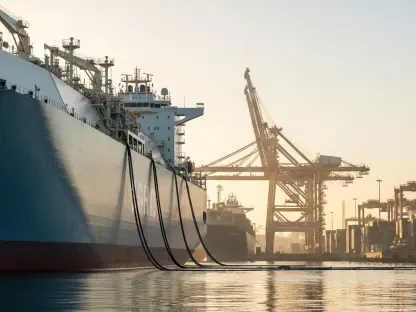Christopher Hailstone has extensive experience with energy management, renewable energy, and electricity delivery. He is also our Utilities expert and provides valuable insights on grid reliability and security.
What are the main factors contributing to the highest amount of new oil supply in a decade expected in 2025?
Several factors are contributing to this surge in oil supply. Major new projects such as the Tengiz field in the Caspian Sea and the Bacalhau field in Brazil play significant roles due to their substantial reserves. Additionally, production expansions in Saudi fields will also add to the global supply. These projects represent large investments and technological advancements that have been in development for some time.
How significant are the roles of the Tengiz field in Kazakhstan and the Bacalhau field in Brazil in this expected increase?
The Tengiz and Bacalhau fields are highly significant. Tengiz is one of the largest oil discoveries in recent times and has massive reserves. Bacalhau in Brazil, with an estimated potential of 1 billion barrels of oil equivalent, is also a major contributor. These mega-projects are pivotal as they promise substantial output, which is expected to meet future global demand.
What are some other notable projects or regions contributing to this potential surge in oil supply?
Aside from Tengiz and Bacalhau, there are expansions in existing Saudi Arabian fields contributing to this surge. Additionally, other regions like the Gulf of Mexico and offshore projects in Africa and Latin America are also expected to ramp up production. These diverse locations showcase the global breadth of new oil production efforts.
How could current oil prices affect the timeline for bringing this new supply to market?
Current oil prices play a crucial role in determining the timeline. If prices remain depressed, it could delay the development and operational start of these projects due to the economic infeasibility of producing at low prices. Companies are cautious about investing heavily when the return on investment is uncertain.
To what extent do industry expectations of depressed prices influence production decisions?
Industry expectations heavily influence production decisions. If companies anticipate prolonged periods of low prices, they might scale back on exploration and development activities. This caution stems from the need to manage costs and avoid overproduction that could further depress prices.
Are there any specific price points that are critical for these projects to remain viable?
Yes, price points around $50 to $60 per barrel are often considered critical for many new projects to remain economically viable. This range allows companies to cover production costs and generate a reasonable return on their investments. Prices below this threshold could hamper profitability and lead to project delays or cancellations.
Can you elaborate on the discrepancy between projections for China’s oil demand growth and its actual import figures?
The discrepancy arises from overly optimistic demand projections versus currently observed import data. While analysts predicted significant growth in China’s oil demand post-pandemic, current import figures suggest a softer rebound, potentially indicating a return to more normalized consumption levels rather than continued high growth.
How might current import trends in China reflect a normalization of demand patterns post-pandemic?
Current import trends likely reflect a stabilization in consumption following the initial post-pandemic surge. As China had been importing crude at record levels to build reserves and meet heightened demand, the recent moderation suggests that the country is returning to pre-pandemic consumption patterns.
What impact could China’s oil consumption have on the global supply-demand balance?
China’s oil consumption is a key determinant of global supply-demand balance. As one of the largest consumers, fluctuations in its demand significantly affect global markets. A stabilization or decrease in Chinese demand could exacerbate the supply overhang, potentially leading to prolonged periods of high inventories and suppressed prices.
What are the different forecasts for the balance between global oil supply and demand?
Forecasts for the supply-demand balance vary. The U.S. Energy Information Administration predicts a modest supply overhang of around 100,000 barrels daily, while Raymond James estimates about 280,000 bpd. The International Energy Agency’s forecast is more bearish, anticipating a 600,000 bpd oversupply.
Why do these forecasts vary so much between sources like the U.S. Energy Information Administration and the International Energy Agency?
Variations arise due to different assumptions and models used by each organization. They consider diverse economic indicators, geopolitical events, and technological advancements, which lead to different projections. These disparities underscore the complexity and uncertainty in predicting global oil markets.
How might these different projections influence market and investment decisions?
Divergent projections can lead to cautious investment approaches. Companies may delay or accelerate projects based on their interpretations of these forecasts. Investors might also seek clearer trends before committing to large capital expenditures, leading to fluctuating market dynamics.
What are the main challenges the oil industry faces in boosting production regardless of oil prices?
Major challenges include technical and logistical difficulties in developing new fields, regulatory hurdles, and the requirement for substantial capital investment. Additionally, geopolitical risks and environmental concerns add layers of complexity that can inhibit swift production increases.
How is the U.S. shale industry being affected by current price levels and production costs?
The U.S. shale industry is particularly sensitive to price fluctuations due to higher production costs. Current price levels create a challenging environment, with companies focusing on efficiency gains and cost-cutting measures. Sustained low prices may lead to reduced drilling activities and lower output.
How do OPEC+ production targets influence the output capabilities of countries like Saudi Arabia?
OPEC+ production targets are crucial in managing supply. Saudi Arabia, as a leading member, often adjusts its output in line with these targets to help stabilize prices. These limits can restrict the country’s ability to ramp up production independently and require coordinated efforts to ensure compliance.
How might renewed U.S. efforts to reduce Iran’s oil exports impact global supply and prices?
Efforts to reduce Iran’s oil exports could tighten global supply and potentially raise prices. With Iran’s current exports contributing significantly to the market, restrictions could lead to short-term supply constraints. However, this impact might be mitigated by other producers scaling up output.
What could be the longer-term effects if significant new supply comes onto the market in 2025?
The introduction of significant new supply by 2025 could lead to prolonged market oversupply, putting downward pressure on prices. This environment might discourage further investments in new projects and shift focus towards efficiency and cost management within the industry.
Why does the head of the International Energy Agency, Fatih Birol, emphasize the need for upstream investments in existing oil and gas fields?
Fatih Birol emphasizes upstream investments to address the natural decline in existing fields, ensuring stable future supply. This focus also highlights the balancing act between meeting current demand and managing the energy transition towards more sustainable sources.
How important are these investments for addressing declines in existing fields and supporting global energy security?
These investments are crucial for ensuring long-term energy security. As existing fields deplete, continued investment is necessary to maintain output levels and prevent supply deficits. They also help buffer the market against sudden disruptions and support a steady transition to alternative energy sources.
Do you have any advice for our readers?
My advice would be to stay informed about global energy trends and understand how geopolitical and economic factors can influence energy markets. Awareness and adaptability are key in a rapidly evolving energy landscape.









